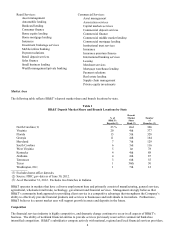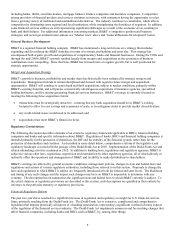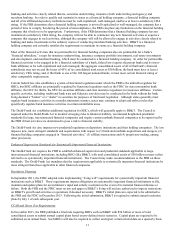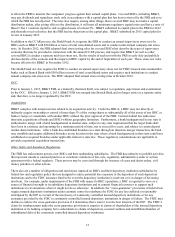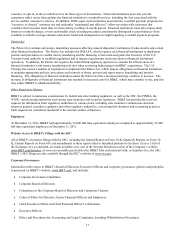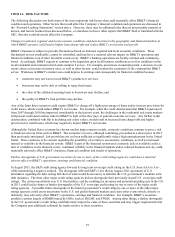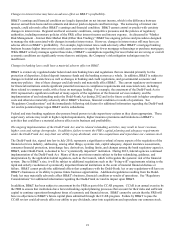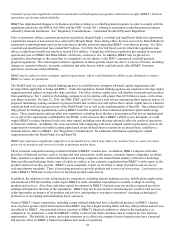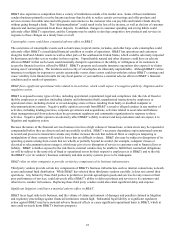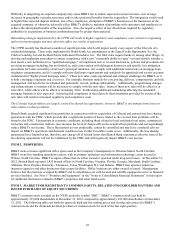BB&T 2012 Annual Report Download - page 37
Download and view the complete annual report
Please find page 37 of the 2012 BB&T annual report below. You can navigate through the pages in the report by either clicking on the pages listed below, or by using the keyword search tool below to find specific information within the annual report.
15
Frank Act as well as the implementation of Basel III. The comment period on these NPRs ended on October 22, 2012. Also
in June 2012, these agencies announced the finalization of their market risk capital rule proposed in 2011.
One NPR proposes the majority of the revisions to international capital standards in Basel III, including a more restrictive
definition of regulatory capital, higher minimum regulatory capital requirements, and the imposition of capital conservation
and countercyclical capital buffers. It also proposes limitations on certain distributions and discretionary bonuses as well as
revisions to the agencies’ prompt corrective action regulations. Another NPR proposes new methodologies for determining
risk-weighted assets, such as by expanding the number and type of exposure categories, providing a more comprehensive
recognition of collateral and guarantees, and introducing or applying more risk-sensitive treatment for certain exposures
(including certain high-volatility CRE, corporate, equity, foreign, securitization, derivative, residential mortgage, and 90 day
or more past due exposures). It also proposes detailed qualitative and quantitative public disclosure requirements relating to
capital adequacy. The final NPR proposes to revise the current advanced approaches risk-based capital rule to incorporate
certain aspects of Basel III as well as certain other revisions to the Basel capital framework published by the BCBS between
2009 and 2011. While BB&T and Branch Bank would be subject to the first two NPRs, they would not be subject to the
third NPR.
While Basel III is intended to be implemented on a global basis beginning January 1, 2013, to be fully-phased in by January
1, 2019, on November 9, 2012 the FRB, FDIC, and OCC issued a joint release announcing that the implementation of the
proposed rules under Basel III in the U.S. would be delayed.
New Minimum Capital Requirements
While uncertainty exists regarding the timing for adoption of the foregoing revised capital standards, if such capital standards
are adopted in their current form, we estimate these standards would have a negligible impact on our ability to comply with
the revised regulatory capital ratios based on our current understanding of the revisions to capital qualification. Once
adopted, banking organizations such as BB&T would be required to meet the following minimum capital and leverage ratios
– 3.5% common equity Tier 1 capital to risk weighted assets, 4.5% Tier 1 capital to risk-weighted assets, 8.0% total capital to
risk-weighted assets and 4% Tier 1 capital to average consolidated assets minus amounts deducted from Tier 1 capital. The
implementation of a capital conservation buffer, effectively raising the minimum capital requirements, will begin on January
1, 2016, at 0.625% of common equity to risk-weighted assets and be phased-in over a four-year period (increasing by that
amount on each subsequent January 1, until it reaches 2.5% on January 1, 2019).
When fully phased-in, the Basel III capital framework will require BB&T and Branch Bank to maintain: (1) a minimum ratio
of common equity Tier 1 capital to risk-weighted assets of at least 4.5%, plus the 2.5% capital conservation buffer; (2) a Tier
1 capital to risk-weighted assets ratio of at least 6%, plus the 2.5% capital conservation buffer; (3) a minimum ratio of total
(that is, Tier 1 plus Tier 2) capital to risk-weighted assets of at least 8.0%, plus the 2.5% capital conservation buffer; and (4) a
minimum leverage capital ratio of 4%, calculated as the ratio of Tier 1 capital to average consolidated assets minus amounts
deducted from Tier 1 capital. Thus, when the capital conservation buffer is fully phased-in, minimum ratios will effectively
be: 7% for Tier 1 common equity, 8.5% for Tier 1 capital, and 10.5% for total capital, with a 4% leverage ratio.
Deposit Insurance Assessments
Branch Bank’ s deposits are insured by the DIF of the FDIC up to the limits set forth under applicable law. The FDIC
imposes a risk-based deposit premium assessment system, which was amended pursuant to the Reform Act and further
amended by the Dodd-Frank Act. Under this system, as amended, the assessment rates for an insured depository institution
vary according to the level of risk incurred in its activities. Effective April 1, 2011, the FDIC implemented a revised
assessment rate calculator, which is based on a number of elements to measure the risk each institution poses to the DIF. The
new assessment rate is applied to total average assets less tangible equity, as defined under the Dodd-Frank Act. The
assessment rate schedule can change from time to time, at the discretion of the FDIC, subject to certain limits. The FDIC has
published guidelines under the Reform Act on the adjustment of assessment rates for certain institutions. Under the current
system, premiums are assessed quarterly.
Consumer Protection Laws and Regulations
In connection with its lending and leasing activities, Branch Bank is subject to a number of federal and state laws designed to
protect borrowers and promote lending to various sectors of the economy and population. These laws include the Equal
Credit Opportunity Act, the Fair Credit Reporting Act, the Truth in Lending Act, the Home Mortgage Disclosure Act, the
Real Estate Settlement Procedures Act, and their respective state law counterparts.





